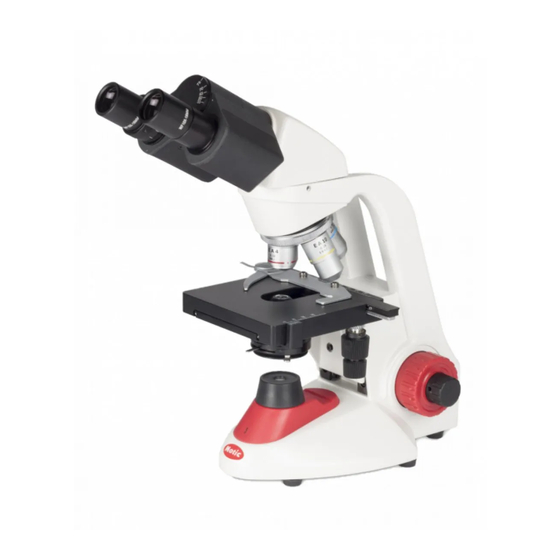
Table of Contents
Advertisement
Quick Links
Advertisement
Table of Contents

Subscribe to Our Youtube Channel
Summary of Contents for Motic RED100 Series
- Page 1 RED100 SERIES Instructions Manual English Motic Incorporation Ltd.
-
Page 3: Table Of Contents
CONTENT Chapter Page Safety instructions 1.1 General safety instructions 1.2 Instrument safety 1.3 Unpacking, transportation & storage 1.4 Waste disposal 1.5 Operation 1.6 Quality warranty Instrument description 2.1 General views 2.2 Part names 2.3 Application 2.4 Instrument and its major features First time use &... -
Page 5: Safety Instructions
Caution! Electric shock hazard! Caution! Danger! 1.2 Instrument safety The RED100 Series biological microscope has been designed, manufactured and inspected according to the EN 61010-1:2001 Safety Requirements for Electrical Equipment for Measurement, Control and Laboratory Use. 1.3 Unpacking, transportation & storage •... -
Page 6: Operation
If there is any electrical failure (of the fuse system, ground protection or transformer), turn off and unplug the unit immediately. Make sure the microscope is set aside so it will not be used again and contact the Motic service department or a Motic microscope repair agency to have it repaired. -
Page 7: Quality Warranty
1.6 Quality Warranty The RED100 Series biological microscope and the attached accessories are only allowed to be used for microscope examination as described in this manual. The manufacturer takes no responsibility for any other use. • The manufacturer guarantees that the product is free from any defect in material or workmanship on the date of delivery. -
Page 9: Instrument Description
2. INSTRUMENT DESCRIPTION 2.1 General Views Eyepiece Monocular Dual View Monocular Monocular Dual View Binocular Head Monocular Head Head Monocular Head Head Head RED-100/101 RED-120 RED-130/131/132 (Cordless model, with rechargeable batteries included) -
Page 10: Part Names
RED100 SERIES 2.2 Part names RED100 1. Eyepiece 8. Collector 2. Monocular head 9. Base (w/ rechargeable batteries and external charger) 3. Lock screw of eyepiece 10. Head lock screw 4. Triple nosepiece 11. Arm 5. 4X/10X/40X objectives 12. Fine focus knob 6. - Page 11 RED132 14. Quadruple nosepiece 21. Binocular head 15. 4X/10X/40X/100X objectives 22. Coaxial coarse and fine focus knob 16. Mechanical stage 17. 1.25 condenser w/ iris diaphragm 18. Stage adjustment knob (X-axis) 19. Stage adjustment knob (Y-axis) 20. Base (w/ rechargeable batteries and external charger)
-
Page 12: Application
RED100 SERIES 2.3 Application The RED100 Series biological microscope is designed for microscopic observation of thin specimens with transmitted, visible light. 2.4 Instrument and its major features Major features of the instrument include: • Built-in LED illumination with brightness adjustment. -
Page 13: First Time Use & Operation
3. FIRST TIME USE & OPERATION 3.1 First time use Before installing and using the biological microscope, make sure to read carefully the Safety Instructions (See Chapter 1). When unpacking and handling, please do not touch the optical surfaces. • After unpacking, place the biological microscope on a flat workbench and remove any foam padding or spacer used to prevent vibration during transportation. -
Page 14: Operation Of The Biological Microscope
RED100 SERIES 3.2 Operation of the biological microscope • Put the specimen on the stage and fix it with the slide clips. Never exam- ine a prepared specimen without a cover slip. Note: The thickness of the cover slip must be 0.17 mm. -
Page 15: Modification Of Biological Microscope
3.3 Modification of biological microscope Unplug the biological microscope before making any modifications. 3.3.1 Replace the head Figure 5a Figure 5b • Unscrew the head lock screw and lift out the existing body tube. (Figure 5a) • Insert the new body tube vertically into pilot hole of the main unit, resting it on the shoulder. (Figure 5b) •... -
Page 16: Maintenance & Troubleshooting
RED100 SERIES 4. MAINTENANCE & TROUBLESHOOTING 4.1 Maintenance The biological microscope is limited to the following maintenance only: • Turn off the power switch after use, and put on the dustproof cover after the microscope has cooled down. • Do not operate the microscope in a room with humidity higher than 75%. -
Page 17: Appendix
≈ 269×150×353mm Biological microscope main unit w/ monocular head Biological microscope main unit w/ dual viewing head ≈ 290×150×392mm Weight 4.5 KG RED100 Series biological microscope Environmental Conditions Transport (within package) : Permissible environment temperature -40 ~ +70°C Storage: Permissible environment temperature +10 ~ +40°C... - Page 18 RED100 SERIES Opto-mechanical parameters Coaxial focus adjustment mechanism: Coarse focus adjustment 4.4mm/rotation 0.42mm/rotation Fine focus adjustment Stroke Separate focus adjustment mechanism: Coarse focus adjustment 18.5mm/rotation Fine focus adjustment 0.09mm/rotation Stroke 11.5mm Nosepiece: Manual triple/quadruple nosepiece Objective: 4X/10X/40X/100X Eyepiece Assembly diameter 23.2mm...
- Page 20 Motic Incorporation Ltd. 130 - 4611 Viking Way. Richmond, BC V6V 2K9 Canada Motic Incorporation Limited Copyright © 2002-2015. All Rights Reserved. Tel: 1-877-977 4717 | Fax: 1-604-303 9043 Design Change: The manufacturer reserves the right to make changes in...
















Need help?
Do you have a question about the RED100 Series and is the answer not in the manual?
Questions and answers